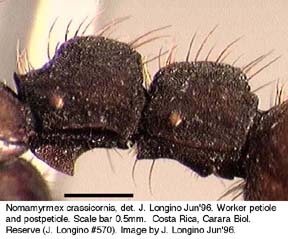



Ecitoninae, Formicidae, Hymenoptera, Insecta, Arthropoda, Animalia
John T. Longino, The Evergreen State College, Olympia WA 98505 USA. longinoj@evergreen.edu
26 March 1997
Identification

| 
|

| 
|
Worker: back of head with deep transverse groove (absent in hartigii); top of petiole longitudinally wrinkled (not wrinkled in hartigii); hind margin of mesonotum nearly straight (as opposed to emarginate in wilsoni).
Male: Border of head behind ocellar peduncle with a narrow lamella (absent in hartigii); first gastric tergite usually with longitudinal rugae; width of blade of stipes about one half its length (wider in hartigii); volsellae blunt, gradually tapered or snout-shaped; setae on fifth gastric tergite continuous across tergite, at least posteriorly (distinctly separated along the midline in wilsoni); longitudinal rugae present on second gastric tergite (indistinct or absent except in sulcus at anterior edge in wilsoni).
Geography
Costa Rica south to Amazon-Madeira-Mamore river system in Brazil and Bolivia. In Costa Rica, known from southern Pacific slope.
Natural History
Nomamyrmex esenbeckii crassicornis is in the tribe Ecitoninae, which are the New World army ants. It shares with all army ants the habits of group raiding and colony nomadism. Nomamyrmex esenbeckii crassicornis forages in columns during the day; I do not know if they forage at night. The workers are robust and their columns very conspicuous. The species is uncommon relative to several species of Eciton and Labidus.
I have seen this subspecies twice with prey and three times in the process of raiding an ant colony. Four of these observations have involved attines. I observed Atta brood as prey in one column, and Acromyrmex brood as prey in another. I observed two attacks on mature Atta cephalotes colonies. Both these raids were observed mid-morning. In the first instance, Nomamyrmex were entering through a collapsed Atta chamber in the middle of a trail, taking away brood. I saw very little response on the Atta's part. There were two dead soldiers near the raiding column. In the second case, Atta workers were abundant on the surface of their mound, and had brought piles of brood to the surface of the largest, most active mounds. Nomamyrmex columns were carrying adult Atta soldiers and brood down into Atta nest entrances, suggesting a largely subterranean raid. I observed one raid on a Pheidole nest.
See also esenbeckii wilsoni, which also has been observed with Attine prey. The two subspecies of esenbeckii are the only army ants I have observed preying upon mature Atta colonies.
How to Collect
Visual search for columns in forested habitats or forest edge during the day.
References
Watkins, J. F. II 1977. The species and subspecies of Nomamyrmex (Dorylinae: Formicidae). Journal of the Kansas Entomological Society 50:203-214.
Page author: John T. Longino longinoj@evergreen.edu
Last modified: 26 March 1997